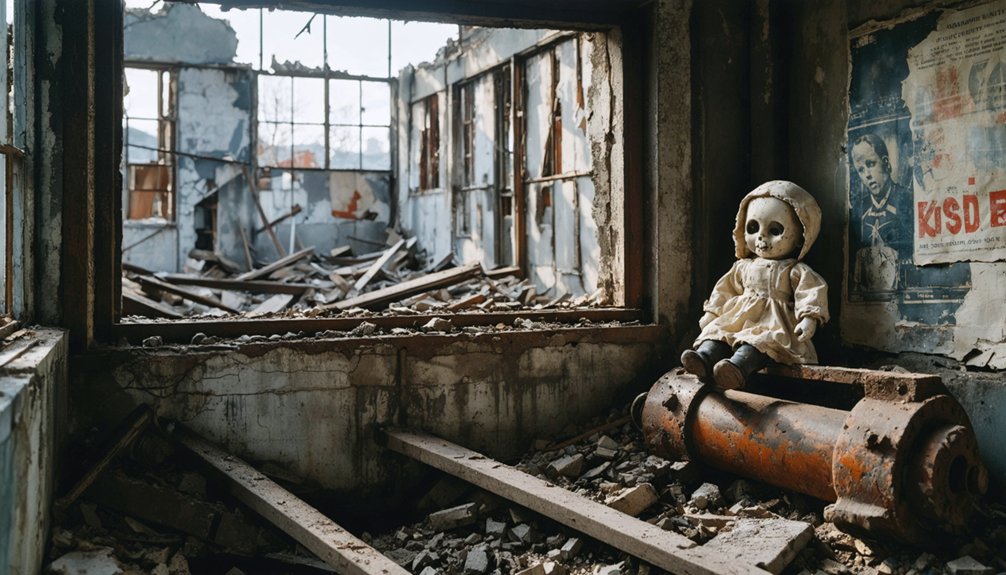Ghost towns emerge when communities can’t adapt to critical disruptions. You’ll find resource depletion often triggered mining town collapses, while transportation shifts like railroad rerouting or highway bypasses isolated once-thriving areas. Natural disasters, climate change, economic evolution, and political upheaval all contribute to abandonment patterns. Many towns faced multiple pressures simultaneously—a once-booming settlement might exhaust its resources just as transportation networks changed. These historical patterns offer sobering lessons for modern community sustainability.
Key Takeaways
- Resource depletion from mining, lumber, and manufacturing created economically fragile communities dependent on single industries.
- Transportation shifts like railroad abandonment and interstate highway bypasses isolated towns from vital commercial traffic.
- Natural disasters and climate change impacts, including flooding, rising sea levels, and extreme weather events, forced permanent abandonment.
- War and political upheaval destroyed infrastructure and communities through violence, forced deportations, and contamination.
- Economic fragility combined with environmental vulnerabilities created unsustainable conditions in communities lacking diversified economies.
The Boom and Bust of Mining and Resource-Based Towns

Five interrelated factors defined the rise and collapse of mining and resource-based settlements that eventually became ghost towns.
Primary among these was resource depletion, as exemplified by Nevada’s Goldfield and Rhyolite, which collapsed within a decade after mineral reserves diminished. Even the legendary Comstock Lode sustained communities for only decades before exhaustion. Nevada’s landscape is dotted with these abandoned settlements that showcase the state’s rich mining history.
Environmental hazards compounded these challenges. Mercury used in gold extraction poisoned water supplies, while asbestos mining created severe health risks, forcing abandonment of towns like Wittenoom. As T. Lindsey Baker noted, these towns existed only while their reason for being remained viable.
Meanwhile, technological changes reduced labor demands, eliminating jobs that once supported thousands.
Government policies further accelerated decline, particularly in Namibia, where the “Sperrgebiet” criminalized new settlements in diamond-rich regions.
Finally, the single-industry dependency left populations vulnerable—when operations ceased, entire communities disappeared as workers sought employment elsewhere.
Transportation Shifts and Bypassed Communities
You’ll find that transportation shifts played a decisive role in creating ghost towns, with railroad rerouting leaving once-thriving communities stranded without commercial lifelines.
When the Interstate Highway System emerged in the mid-20th century, towns bypassed by new routes like Interstate 94 in North Dakota experienced rapid economic decline as traffic-dependent businesses lost their customer base.
These transportation changes often worked in tandem with other factors, creating a compounding effect where bypassed communities faced diminishing commercial viability, infrastructure neglect, and ultimately, abandonment. Similar to how pandemic-related commuting behavior shifts altered transit ridership patterns, these historical transportation changes redirected human movement away from certain areas. Current projections suggest this pattern may continue, with up to 43 percent of US cities already experiencing population loss that could eventually lead to similar outcomes.
Railroad Town Obsolescence
Throughout the twentieth century, the decline of America’s railroad towns illustrates how transportation infrastructure shifts can fundamentally reshape communities and regional economies. Nearly 40% of railroads were abandoned, with deregulation accelerating this trend, allowing companies to discard unprofitable lines regardless of community impact.
Railroad decline triggered profound community disintegration. Towns that once thrived as “railroad suburbs” withered when automobile-dependent infrastructure proliferated. Many communities suffered the same fate as the Peninsular Railway project in Mexico, which was abandoned after only 27km of track completion. Main Streets and downtown hotels that anchored rail-focused communities collapsed as supermarkets and shopping centers emerged elsewhere. Research has shown that communities experienced lower wages after railroad abandonments occurred, contributing to economic hardship in affected areas.
Small railroad towns lacked economic diversity to survive technological obsolescence. Passenger services disappeared incrementally—first branch lines, then flagship routes like the Milwaukee Road’s Olympian Hiawatha.
Highway Bypass Casualties
When a community’s lifeblood traffic is suddenly rerouted around its borders, the consequences can be devastating.
You’ll find statistical evidence of this economic isolation in the 50% decrease in highway-generated trade and 10-15% drops in per capita sales, particularly affecting gas stations and restaurants.
Bypass impacts extend beyond mere numbers—they reshape community identity.
Towns suffering the greatest damage typically have economies heavily dependent on pass-through traffic. Clarksdale, Mississippi exemplifies how bypasses can devastate local businesses when traffic is diverted.
With up to 43.8% of businesses reporting decreased sales and approximately 14% of jobs lost (mostly part-time positions), the downward spiral often leads to population decline.
The traffic volume ratio between bypass and original routes determines a town’s fate.
Communities lacking economic diversity frequently evolve toward ghost town status, with former residents lamenting towns on “their last heartbeat” as vibrant community centers disappear.
Natural Disasters and Environmental Catastrophes

Natural disasters and environmental catastrophes represent some of the most devastating forces behind the creation of ghost towns worldwide.
Communities like Valmeyer, Illinois and Times Beach, Missouri showcase the permanent flooding impacts when waters inundate settlements beyond recovery. The Mississippi River’s 1993 flood forced nearly all of Valmeyer’s residents to relocate to higher ground, while Times Beach’s flooding spread toxic dioxin, requiring complete evacuation. Holland Island in Chesapeake Bay witnessed its community dissolve as rising sea levels gradually claimed homes until the last house collapsed in 2010.
Cyclone devastation creates similar abandonment, as witnessed in Myanmar where Cyclone Nargis‘ storm surge traveled 25 miles inland, killing over 80,000 people across the Irrawaddy Delta.
Bogale was completely flattened, with 10,000 deaths and 55,000 missing. In Fiji, Vunidogoloa became the first of many villages forced to relocate due to rising seas and powerful cyclones that repeatedly submerged coastal communities. The small town of Centralia, Pennsylvania became uninhabitable after a coal mine fire ignited beneath the town in 1962, causing hazardous conditions that continue to this day.
Economic Evolution and Industrial Obsolescence
Economic booms built around single industries created thousands of short-lived settlements that collapsed when their primary economic engine stalled.
You’ll find that these boom-to-bust cycles typically occur when towns rely entirely on extractive industries like mining, timber, or oil, leaving them vulnerable when resources deplete or market demand shifts.
Historical evidence demonstrates that communities lacking economic diversification face catastrophic population loss and abandonment once their sole industry becomes obsolete or relocates. This phenomenon is evident in China where rapid urbanization has created numerous ghost cities as infrastructure development outpaced actual population demand.
Boom-to-Bust Economic Cycles
The dramatic life cycle of ghost towns often begins with a spectacular economic surge that, like a flame burning too brightly, eventually consumes its own fuel source.
Boomtown growth emerges when valuable resources like gold or oil are discovered, triggering rapid population influxes as workers and entrepreneurs rush to capitalize on newfound opportunities. What were once empty landscapes transform into vibrant “instant cities” with diverse businesses and bustling streets.
Yet this prosperity masks inherent economic fragility. Towns dependent on single industries remain vulnerable to market fluctuations, resource depletion, and technological obsolescence.
When commodity prices plummet or resources are exhausted, the ripple effects devastate local economies. Buildings are abandoned, businesses close, and residents depart.
The same forces that created these communities ultimately lead to their demise, leaving behind haunting reminders of boom-to-bust cycles.
Single-Industry Dependency Collapse
When a community stakes its entire existence on a single industry, it risks catastrophic collapse should that economic pillar falter or disappear. This economic monoculture created vulnerability in numerous towns throughout American history, from Kennicott, Alaska to Bruceton, Tennessee.
You can observe this pattern across various sectors: mining communities abandoned when mineral veins ran dry, lumber towns deserted when forests were harvested, and manufacturing hubs emptied when factories relocated.
Resource depletion often occurred faster than communities could adapt, as seen in places like Castle Dome, Arizona, where declining ore quality rendered mining unprofitable.
Without economic diversification, these towns lacked resilience against market shifts, technological advances, and changing regulations.
When the primary employer shuttered operations, residents had no choice but to seek opportunities elsewhere, leaving behind the skeletal remains of once-thriving communities.
The Impact of War and Political Upheaval

Violent conflicts and political instability have transformed countless thriving communities into ghost towns throughout history, creating some of the most dramatic examples of human displacement and settlement abandonment.
War violence often manifests through massacres and forced deportations, as seen in Oradour-sur-Glane, France, where Nazi forces killed 642 residents, leaving the town permanently deserted.
Military requisitions can similarly devastate communities, exemplified by Tyneham, England, evacuated in 1943 for army training and never reoccupied.
Nuclear contamination presents another wartime legacy, with Pripyat near Chernobyl standing as a stark reminder of how technological disasters can render areas uninhabitable for generations.
The destruction of crucial infrastructure during political upheavals compounds these effects, eliminating economic foundations that might otherwise enable communities to rebuild after conflicts subside.
Climate Change and Environmental Deterioration
Climate change and environmental deterioration have emerged as powerful forces behind ghost town formation in recent decades, transforming once-vibrant communities into abandoned settlements through both gradual and sudden processes.
The environmental shifts driving these abandonments occur through several mechanisms:
- Rising sea levels erode coastal communities, submerging infrastructure and forcing relocation, as witnessed in Burrwood, Louisiana.
- Intensifying drought depletes critical water resources, devastating agricultural economies in places like Es-Sfalat Tafilalet, Morocco.
- Extreme weather events destroy infrastructure beyond repair, compelling mass evacuations as seen in Valmeyer, Illinois after catastrophic flooding.
- Melting permafrost destabilizes Arctic settlements’ foundations, making towns like Newtok, Alaska uninhabitable.
These climate impacts disproportionately affect vulnerable communities, accelerating migration from areas where environmental conditions no longer support human habitation.
Frequently Asked Questions
How Long Does a Typical Ghost Town Take to Become Completely Abandoned?
You’ll observe abandonment timelines varying from a few years to several decades. Resource-dependent towns often collapse within 10-20 years, while gradual urban decay typically extends abandonment across 20-50 years.
Can Ghost Towns Legally Be Reclaimed by Private Individuals?
Despite romantic visions of staking claims, you’ll face significant legal challenges reclaiming ghost towns. Yes, they can be privately acquired, but property rights depend on clear ownership, zoning restrictions, and regulatory compliance.
Which Countries Have the Highest Concentration of Ghost Towns?
The United States, Bulgaria, and China possess the highest concentrations of ghost towns. You’ll find these abandoned cities preserve historical significance while reflecting each nation’s unique economic, political, and environmental development trajectories.
Are There Successful Examples of Ghost Towns Being Revitalized?
Yes, you’ll find Jerome, Bodie, and Matera exemplify successful ghost town revitalizations through economic incentives like flexible zoning, arts development, and heritage tourism-focused revitalization strategies that preserve authenticity while creating viability.
How Do Governments Typically Manage the Infrastructure of Abandoned Towns?
Governments employ infrastructure maintenance strategies through vacant property registration programs, land banks, and urban planning initiatives that remediate hazards, secure utilities, and strategically allocate resources for potential redevelopment or controlled abandonment.
References
- https://history.howstuffworks.com/history-vs-myth/ghost-towns.htm
- https://westernmininghistory.com/664/what-is-a-ghost-town-wmh-town-classifications-explained/
- https://www.merriam-webster.com/dictionary/ghost town
- https://www.britannica.com/topic/ghost-town
- https://en.wikipedia.org/wiki/Ghost_town
- https://plainenglish.com/lingo/ghost-town/
- https://texashighways.com/culture/history/what-the-heck-is-a-ghost-town/
- https://exhibits.lib.utah.edu/s/ghost-towns/page/Introduction
- https://grokipedia.com/page/Ghost_Town
- https://www.smithsonianmag.com/sponsored/nevadas-living-and-abandoned-ghost-towns-180983342/



